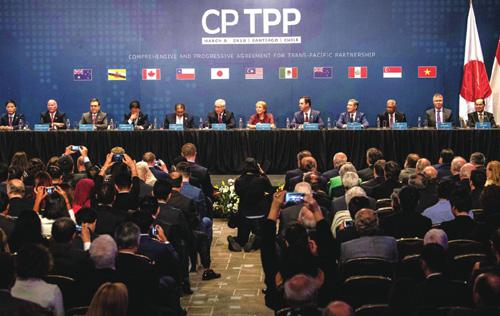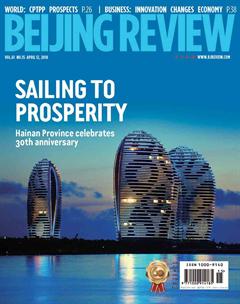The CPTPP:An Uncertain Prospect
By Wen Qing

After U.S. President Donald Trump signed the order to withdraw from what he called the “potential disaster” of the Trans-Pacific Partnership (TPP), everyone left it for dead. However, the remaining 11 TPP member countries took a different view and agreed to move forward. Finally, Australia, Brunei, Canada, Chile, Japan, Malaysia, Mexico, New Zealand, Peru, Singapore and Viet Nam signed the revised agreement in Chile on March 8, and the TPP was reborn as the Comprehensive and Progressive Agreement for Trans-Pacific Partnership (CPTPP). But without the participation of China and the United States, the two biggest economies across the Pacific Ocean, is it really as comprehensive and progressive as it declares?
A weakened TPP
“The TPP, as a strategic U.S. plan, was more like a closed system,” said Han Liqun, a researcher with the China Institutes of Contemporary International Relations (CICIR), in an interview with Beijing Review. He noted that, among the 12 members that made up the TPP, Malaysia, Australia, New Zealand and Canada have rich raw materials. The United States, Canada, Japan and South Korea are all strong manufacturing powers. Meanwhile, the United States is also one of the biggest consumer markets in the world. Therefore, the TPP was a closed trade system which could have operated well without participation from other countries.
According to Han, with the absence of the United States as a huge consumer market, the CPTPP cannot run in this closed model. Therefore, the CPTPP is merely another average regional trade bloc, in contrast to the strategic meaning of the TPP before U.S. withdrawal.
The TPP was different from past free trade agreements which focused on the convenience of trade and investment. It involved regulations on the free fl ow of personnel and capital, protection of intellectual property rights, protection of labor rights and the environment, as well as restrictions on preferential policies for stateowned enterprises.
“A design mechanism built on such high standards reflects the United Statesstrategic plans to play the dominant role in reshaping the rules of global trade,” said Han. However, the CPTPP, although retaining most of the original TPP text, lowered standards by suspending or altering 22 provisions about intellectual property protection and investment. For example, the length of patent protection for innovative medicine has been slashed, and the availability mechanism for foreign investors to sue the host member state has also been narrowed, Han added.
Moreover, “the influence of the new organization is weakened when you consider its decreased overall economic power,” said Ni Jianjun, Deputy Director of the Institute of World Economic Studies at the CICIR. The 11 member countries account for 13.5 percent of the global GDP and 15.2 percent of total global trade turnover, much lower than the TPPs 38.2 percent of global GDP and 26.5 percent of trade turnover. “Although it retained some high standards from the TPP, considering its overall slashed economic power, the CPTPP is in no position to play the role of rewriting rules for global trade or leading globalization as it has declared,” Ni noted.
Prospects for the CPTPP
According to the rules of the CPTPP, it will take effect 60 days after being approved by at least six countries, which is much easier than that of the TPP.
“But its outlook remains unclear,” Ni told Beijing Review. Obstacles still exist for approval. For instance, the protectionist forces of these countries will probably try to impede its approval as it may damage their vested interests, Ni explained.
Although immensely ambitious due to its economic size within the bloc, Japan is not up to the task of leading the CPTPP, Ni said. After the withdrawal of the United States, the CPTPP became less appealing to the Association of Southeast Asian Nations(ASEAN) which had initially been attracted to the TPP by the huge consumer markets in the United States and the rich resources in Australia and Canada.
Jiang Yuechun, a senior researcher at the China Institute of International Studies, echoed Nis comments, offering as proof Japans adoption of agriculture protectionism to avoid international competition by protecting the socalled “sacred fi ve” products: rice, wheat, beef and pork, dairy products and sweeteners such as sugarcane and beets.
“The tariff on foreign rice is as high as 600 percent,” Jiang said. “Joining the CPTPP means Japans tariffs on importing agricultural products would decrease to zero, which means a big hit to local agricultural sectors. Thats why many powerful agriculture lobbies criticized Japans role,” he explained.
Nevertheless, Jiang pointed out that considering Japans overall trade strategy, Japanese Prime Minister Shinzo Abe will vigorously promote the CPTPPs approval. By attempting to play a leadership role in guiding the region in reshaping global trade rules, Japan aims to counterbalance and isolate the growing Chinese economy.

Moreover, Jiang claimed that although the CPTPP is unlikely to become the dominate model for Asia-Pacifi c trade, it could still have some infl uence on the making of trade rules in the region. With more countries promising participation in the future, markets could be further expanded, attracting more manufacturing nations and resource exporters.
Experts agree that some of the high standards preserved in the CPTPP reflect the direction of the future development of global trade as it is suited to the values and ideas of modernization. It is an attempt to promote advanced concepts and reflect the common aspirations of all humanity.
However, Han said, the stage of development and the reality of Asian countries must also be considered.
Ni shared similar views, adding that the standards inherited from the TPP were guided by the United States—a non-Asian country—which has led to the agreement being out of sync with the economic development situation of most Asian countries. In contrast, the Regional Comprehensive Economic Partnership, which was put forward by ASEAN countries, is a regional trade arrangement more suitable to Asias current development model and level.
Influence on China
The CPTPP will inevitably exert some infl uence on China, but should not be exaggerated since it is limited, according to Han. Among the 11 member countries, China is the largest trade partner of eight of them, namely Japan, Australia, Singapore, Viet Nam, Malaysia, New Zealand, Chile and Peru. In 2017, bilateral trade between China and Japan exceeded $300 billion. In addition, China is the second largest trade partner of Canada and Mexico.
China is also part of the China-ASEAN Free Trade Area (CAFTA), which was established in 2010, and is among the three largest regional economic zones in the world today along with the European Union and the North American Free Trade Agreement. During years of development, CAFTA has been continuously upgraded to facilitate the convenience of bilateral trade, investment and the development of e-commerce. China has also signed free trade agreements with Australia, Chile, Peru and New Zealand.
“In the Asia-Pacific region, various free trade agreements coexist. Even if the CPTPP were to go into effect by 2019 as scheduled, it would just be one of many regional trade cooperation organizations. Member countries will be unlikely to sacrifice trade relations with China to engage in the new organization considering their critical economic links with China,” said Ni.

